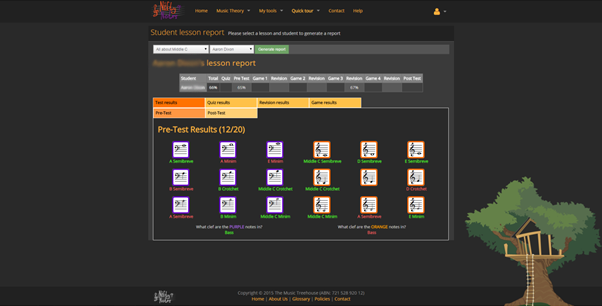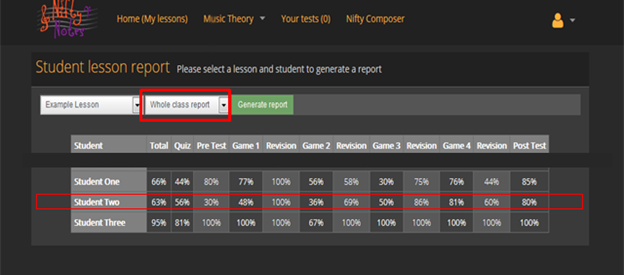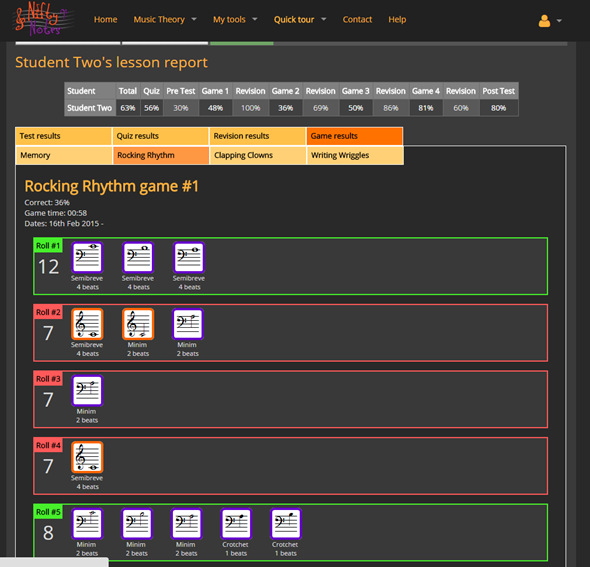Monitor your students / reporting
During your initiation phase of Nifty Notes – the Dawson Method of Reading Music, both students and teachers are taken through a step by step guide. The students’ guide is provided by engaging animation by our Australian Rosella “Nifty Nev”, that continues throughout the program. The teachers’ guide is provided by pop-up information at key stages. Previews of all games within module 1 are accessible from the home page, as are comprehensive teacher tutorials.
Lesson summaries are provided to all students at the beginning of each lesson, outlining the learning goals, aims, objectives and criteria to be reached within that lesson.
Assessment is embedded in learning activities. Nifty Notes – The Dawson Method of Reading Music enables the teacher to easily set learning goals for students, both individually or as a group by providing clear formative, summative and ipsative assessment reports. The program emphasizes the interaction between learning and manageable assessment strategies. Teachers can set “class tests” for individual students, or an entire classroom environment. Full statistical and historical reporting per class and per student is generated.
Pre-tests are generated at the beginning of each lesson plan to determine the level of knowledge a student has, providing a diagnostic and objective test with statistical results that are easily viewed by the teacher. The post-tests that are generated at the end of each lesson plan provide ipsative and summative assessment of what the student has now learned as a direct result of progressing through the lesson plan.
EXAMPLE OF A PRE-TEST STUDENT REPORT

Nifty Notes is a managed learning environment. Assessments can be formulated as a group (collaborative learning), an individual (independent learning) or a whole class. Default “Class Tests” within each module are pre-loaded to the system providing formative assessment using a comprehensive multiple choice examination on all areas of theory studied. However, if a teacher requires a different class test, these can be easily written by including or excluding the system generated questions.
Instructional Design (coming soon!): As a result of the assessments, students and teachers can be directed to a particular area of theory that may require revision, providing an opportunity for improvement.
Live viewing (coming soon!): Will provide synchronous communication to teachers in real-time to enable them to provide assistance to those students who are having difficulty achieving their learning outcomes. Progress can be monitored both live, and from statistical reporting methods.
An Interactive Chat-box (coming soon!) will provide scaffolded instruction allowing the teachers to provide support and feedback to the students. This interactive method is particularly important in a remote learning environment, but can also be helpful during homework assignments and day to day communication.
A Certificate of Completion is provided to each student at the end of each completed lesson plan providing them with an overall result.
Students can be monitored at individual competency levels and promoted to higher modules using module defaults or more complex lesson plans set by the teacher.
Nifty Notes – The Dawson Method of Reading Music has been designed in conjunction with the NSW Board of Studies Syllabuses for K-12 2003-2009.
Assessment and Reporting – All Stages: Nifty Notes – The Dawson Method of Reading Music enables the teacher to easily set learning goals for students, both individually or as a group and clear formative, summative and ipsative assessments are reported. The program emphasizes the interaction between learning and manageable assessment strategies. Teachers can set “Class Tests” for individual students, or an entire classroom environment. Full reporting per class and per student is generated.
Whole class reports provide a clear overview of all students’ results within a lesson plan.

We see in this report for example that Student-Two scored 30% in the Pre-Test and after progressing through the lesson plan program, scored 80% in the Post-Test. If however, we want to look a little more closely at Student-Two to assess where additional study may be needed, we simply check the student’s personal lesson report. In this case, the student performed unsatisfactorily in Game 2 (Rocking Rhythm dice game).

We can see in this example that student’s first throw of the dice amounted to 12. The student may know therefore that a semibreve equals four beats, as they have chosen three of them correctly. However, the second throw amounted to 7 and the student was unsure of the values of minims and crotchets so more revision may be needed in this area. The system will keep asking the student to “roll again” to enable the student to revise their score. (All student results are shown by scrolling down).




